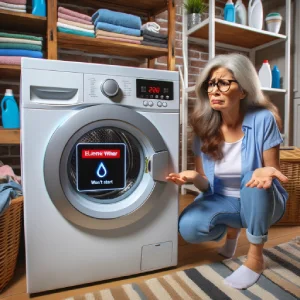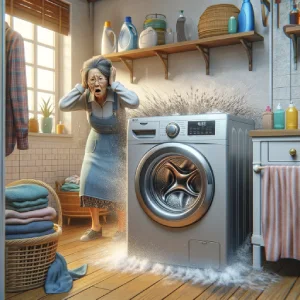6 Common GE Washer Control Board Problems: Causes and Fixes

GE washers are well-known for their excellent features, durability, and reliability. However, just like with any other home appliance, they occasionally experience control board problems.
GE washing machines can experience some common mechanical problems, from washer leakage to complete failure. In some cases, the users experience problems like the washer failing to start or making loud noises.
Most of these issues can be fixed by simply resetting the control board or replacing it with a new one. In the following headlines, let’s elaborate on these issues and their possible causes and fixes in more detail.
What are the GE Washer Control Board Problems?

Over time, you may experience several issues with the control board in GE washers, which can cause various problems. Some of them may include:
- Failure to start
- The washer Behaves unusually
- Making unusual noises
- Fails to meet accurate temperature or water level
- Displaying error codes
- Display doesn’t show any results
Troubleshoot and Fix For GE Washer Control Board Problems
If you’re experiencing issues with your GE washer control board, you may be able to troubleshoot and fix the problem yourself before calling for professional help.
So, now let’s bring out these GE washer control board problems and their potential fixes:
1. GE Washer Won’t Start
The timer or control board is responsible for initiating the wash cycle. So, if the control board in a GE washer is defective or malfunctioning, it could prevent the washer from starting.

Sometimes, there might be no power supply to the washer, causing the control board to malfunction. So, make sure the washer is plugged into the outlet and getting power properly.
Also, verify the circuit breaker to see if it is not tripped. If it is, then reset the circuit breaker and see if the control board powers on.
The control board on your GE washing machine can also malfunction due to software glitches.
So, disconnect the washer from the outlet for at least one minute, and then reconnect it. This will reset the board and fix the minor software glitches.
Therefore, examine the board for any signs of damage, such as distressed components or loose or bent connections. In this case, repairing or replacing the board will serve the best.
2. The Washer Behaves Unusually
Another common GE washer control board problem is its inconsistent behavior. The washer may exhibit erratic behavior, such as stopping mid-cycle, skipping cycles, or running excessively long cycles.

This can occur when the control board fails to communicate properly with the washer’s components.
If your GE washer control board is causing skipping or long cycling, here are a few steps you can take to troubleshoot and fix the issue:
- First, try to reset the control board. It will fix any temporary issues.
- Inspect the board and see if there are any signs of damage. If it is damaged, you will need to replace it.
- Dust and debris may accumulate on the control board over time, causing malfunctions. So, clean the board, ensuring there is no loose debris or residue.
- Test the control board using a multimeter for the proper voltage. If the readings are not within the specific range, consider replacing the control board.
3. Experiencing Excessive Noise
This is one of the most common GE washer control board problems. You may experience this problem when your washing machine is old.

There could be several reasons why a GE washer control board is making excessive or unusual noises. Some common causes include:
- Faulty internal components
- Loose connections due to wear and tear or improper installation
- The control board is overheated
- Mechanical issues such as faulty motor bearings or worn-out parts
- Water or moisture damage
Once you know the causes, here are some potential fixes you can try to fix your GE control board that is making unusual noises:
- Inspect the control board for any loose or damaged components.
- Check the entire control board and inspect if the components are burning, melting, or corroding. If there’s a problem like that, replace the faulty components as needed.
- Check for any symptoms of water damage, such as moisture or rust on the control board. If water damage is present, it could be the cause of the excessive noises, and the board may need to be replaced.
- Remove dust and debris from the control board and check for any broken or stuck objects inside the board. Fix any broken objects if they are found.
4. Incorrect Temperature or Water Level Control
The control board plays a crucial role in regulating the temperature and water level during a wash cycle.

When the control board is bad, it fails to accurately sense or communicate the temperature settings to the washer’s heating element.
As a result, it may cause improper temperature or water level adjustments. To fix temperature control issues on a GE control board, here are the steps to follow:
- First, reset the washer and see if the problem is resolved.
- Then verify the water supply to see if the washer is not disabled or restricted.
- Locate the water inlet filters and screens and clean or replace them if necessary.
- Inadequate water pressure can cause incorrect water levels. So, make sure the water pressure in your home meets the manufacturer’s recommendation.
5. Display doesn’t show any information
The display panel may not light up or show any information when the control board is defective.
Error codes may also be displayed incorrectly or not at all. To fix this problem, you can take the following steps:
- Ensure the GE washer is properly plugged in.
- Reset the control board to resolve minor issues and check to see if the display is working again.
- If it is not, then check the wiring connections on the control board. After checking, if you find any issues, repair or replace the affected connectors or wires.
- Finally, test the control board using a multimeter.
6. Faulty GE Control Board Error Code
When the GE washer control board is faulty, the display may light up with several error codes, including E57, E58, or E71.
The codes will indicate that the main timer or control board is faulty and that the machine won’t work properly. To fix these codes, try the following solutions:
- Unplug the washer from the power source and plug it back in to reset the machine. Turn the washer on to see if the error code persists.
- Check for any loose or damaged wiring connections to the control board. Repair or replace the damaged wiring if found.
Now power your GE washing machine back up and see if the issue continues. If you still notice the error code on the board, you may need to replace the entire control board.
Note: Always ensure that the washer is unplugged from the outlet before attempting any troubleshooting or repairs to prevent electrical hazards.
How Do I Protect the GE Washer Control Board?
GE washer control board problems are common, but not obvious. With some regular maintenance and care, most of these issues can be prevented.
- Ensure proper power supply to the machine.
- Clean the filter and control board regularly.
- Ensure enough ventilation.
- Make sure to check the wiring connections to the control board regularly.
- Don’t let water or other moisture enter the control board.
FAQs
While searching for GE control board problems, you may also have some frequently asked questions and want to know their answers. In the following questions, we’re going to help you with that.
How much does it cost to replace a faulty GE washer control board?
On average, the replacement cost of a bad GE washer control board is estimated at between $150 and $300. The parts will cost from $95 to $116, while the labor cost will be around $55-$185.
How do you put a GE washing machine in diagnostic mode?
To put your GE washer in diagnostic mode, first, press and hold the start button. Then rotate the cycle selector knob to the left seven times. Once you have done this, release the start button, and with that, the washer has entered diagnostic mode.
Can a GE washer control board be repaired?
Yes, fortunately, you can repair a faulty GE washer control board if it is not entirely damaged. It can be repaired in two ways: either back into the original GE washer, or used in a different device after being recycled.
Conclusion
Some GE washer control board problems may require professional help, but not all control board problems are tricky to handle. With proper DIY knowledge and repair skills, they can be fixed easily.
But it’s also important to be aware of the signs of GE control board malfunctions so you can resolve the issue before it gets worse. Therefore, don’t choose to buy a replacement before testing the entire control board.






